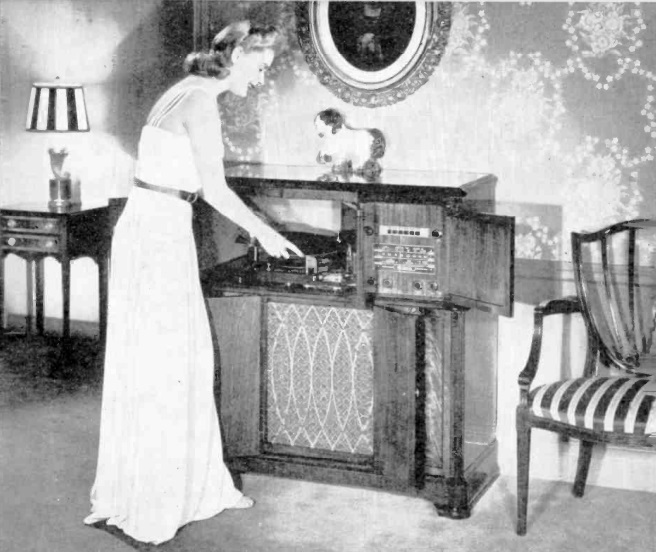 As we’ve noted before, people used to dress up to listen to the radio or play records, as shown by this photograph on the cover of the October 1941 issue of National Radio News.
As we’ve noted before, people used to dress up to listen to the radio or play records, as shown by this photograph on the cover of the October 1941 issue of National Radio News.
The woman operating this phonograph had a good reason to get dressed up, because the radio-phono was the RCA Victrola model V-225. The radio pulled in standard broadcast and two shortwave bands, and it had an automatic record changer.
But calling it an “automatic record changer” is a serious understatement. It was actually a miracle of engineering. Not only would it play the records automatically, but it would play both sides of each record, thanks to a dual tone arm with a needle on both the top and bottom. To play the “B” side, the motor would stop and then change direction. The system is explained in detail in the magazine:
The “Magic Brain,” RCA Victor’s new automatic record playing mechanism illustrated on the front cover of this issue, is magical in its uncanny, almost human operation. The mechanism, by use of a radical new Tandem Tone Arm, plays both sides of records without turning them over.
The turntable automatically moves aside to discard a record which has been played on both sides, and returns to position and finds the center hole of the next record to be played. This feature is unique in automatic record changing devices and is made possible by the use of two motors. one to drive the turntable and the other to operate the automatic mechanism. This also makes it possible to increase the capacity of the mechanism to fifteen 10-inch records or twelve 12-inch records.
As soon as the Tandem Tone Arm bas played both sides of a record, it swings free to permit the turntable assembly to tip over to the left, gently carrying the record into the padded pocket below the mechanism. While the turntable is in this position, the next record in the stack drops silently to the heavily felted motor board. The turntable then returns to its original position, raising the record from the motorboard enroute. While the record is held in position by the record support posts, the turntable spindle seeks out the center hole of the record to be played and finds it, positioning the record for playing. The turntable is no larger than the size of the record label, in order to permit the lower section of the Tandem Tone Arm to play the under side.
The Tandem Tone Arm is actually two complete Magic Tone Cell pick-ups set, one above the other. into a tune arm shaped somewhat like at tuning fork. Its action is completely automatic from the time it leaves the rest position at the touch of the starting button, until it returns to rest after the last record has been played. Since the vibrating parts of the unit weigh less than a postage stamp, no undesirable mechanical noise or needle chatter is created.
Among the many other features which are attracting much interest as the ‘Magic Brain” is demonstrated are the Magic Tone Cell (or pickup cartridge), the Flexible Toue Bridge and the Jewel-Lite Scanner. The Tone Bridge connects the sapphire Jewel-Lite Scanner (replacing the standard needle) to the Magic Tone Cell.
The new “Magic Brain” with its Tandem Tone Arm is incorporated in the 1942 RCA Victrola model V-225 combination three -baud receiver and automatic phonograph, which is the receiver pictured on the front cover.
You can see this remarkable changer in action at the following video:
